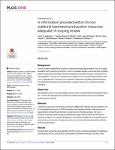Is information provided within chronic subdural haematoma education resources adequate? A scoping review
| dc.contributor.author | Gillespie, CS | |
| dc.contributor.author | Khanna, S | |
| dc.contributor.author | Vivian, ME | |
| dc.contributor.author | McKoy, S | |
| dc.contributor.author | Yanez Touzet, A | |
| dc.contributor.author | Edlmann, E | |
| dc.contributor.author | Stubbs, DJ | |
| dc.contributor.author | Davies, BM | |
| dc.date.accessioned | 2023-04-24T15:16:30Z | |
| dc.date.available | 2023-04-24T15:16:30Z | |
| dc.date.issued | 2023-04-06 | |
| dc.identifier.issn | 1932-6203 | |
| dc.identifier.issn | 1932-6203 | |
| dc.identifier.other | ARTN e0283958 | |
| dc.identifier.uri | https://pearl.plymouth.ac.uk/handle/10026.1/20758 | |
| dc.description.abstract |
Background Chronic subdural haematoma (CSDH) is becoming increasingly prevalent, due to an aging population with increasing risk factors. Due to its variable disease course and high morbidity, patient centred care and shared decision making are essential. However, its occurrence in frail populations, remote from specialist neurosurgeons who currently triage treatment decisions, challenges this. Education is an important component of enabling shared decisions. This should be targeted to avoid information overload. However, it is unknown what this should be. Objectives Our objectives were to conduct analysis of the content of existing CSDH educational materials, to inform the development of patient and relative educational resources to facilitate shared decision making. Methods A literature search was conducted (July 2021) of MEDLINE, Embase and grey literature, for all self-specified resources on CSDH education, and narrative reviews. Resources were classified into a hierarchical framework using inductive thematic analysis into 8 core domains: Aetiology, epidemiology and pathophysiology; natural history and risk factors; symptoms; diagnosis; surgical management; nonsurgical management; complications and recurrence; and outcomes. Domain provision was summarised using descriptive statistics and Chi-squared tests. Results 56 information resources were identified. 30 (54%) were resources designed for healthcare professionals (HCPs), and 26 (46%) were patient-orientated resources. 45 (80%) were specific to CSDH, 11 (20%) covered head injury, and 10 (18%) referenced both acute and chronic SDH. Of 8 core domains, the most reported were aetiology, epidemiology and pathophysiology (80%, n = 45) and surgical management (77%, n = 43). Patient orientated resources were more likely to provide information on symptoms (73% vs 13%, p<0.001); and diagnosis (62% vs 10%, p<0.001) when compared to HCP resources. Healthcare professional orientated resources were more likely to provide information on nonsurgical management (63% vs 35%, p = 0.032), and complications/recurrence (83% vs 42%, p = 0.001). Conclusion The content of educational resources is varied, even amongst those intended for the same audience. These discrepancies indicate an uncertain educational need, that will need to be resolved in order to better support effective shared decision making. The taxonomy created can inform future qualitative studies. | |
| dc.format.extent | e0283958-e0283958 | |
| dc.format.medium | Electronic-eCollection | |
| dc.language | en | |
| dc.publisher | Public Library of Science (PLoS) | |
| dc.subject | Humans | |
| dc.subject | Aged | |
| dc.subject | Hematoma, Subdural, Chronic | |
| dc.subject | Educational Status | |
| dc.subject | Decision Making, Shared | |
| dc.title | Is information provided within chronic subdural haematoma education resources adequate? A scoping review | |
| dc.type | journal-article | |
| dc.type | Review | |
| plymouth.author-url | https://www.ncbi.nlm.nih.gov/pubmed/37023014 | |
| plymouth.issue | 4 | |
| plymouth.volume | 18 | |
| plymouth.publication-status | Published online | |
| plymouth.journal | PLOS ONE | |
| dc.identifier.doi | 10.1371/journal.pone.0283958 | |
| plymouth.organisational-group | |Plymouth | |
| plymouth.organisational-group | |Plymouth|Research Groups | |
| plymouth.organisational-group | |Plymouth|Faculty of Health | |
| plymouth.organisational-group | |Plymouth|REF 2021 Researchers by UoA | |
| plymouth.organisational-group | |Plymouth|Users by role | |
| plymouth.organisational-group | |Plymouth|Users by role|Academics | |
| plymouth.organisational-group | |Plymouth|REF 2021 Researchers by UoA|UoA01 Clinical Medicine | |
| plymouth.organisational-group | |Plymouth|Faculty of Health|Peninsula Medical School | |
| plymouth.organisational-group | |Plymouth|Research Groups|FoH - Applied Parkinson's Research | |
| plymouth.organisational-group | |Plymouth|Users by role|Researchers in ResearchFish submission | |
| plymouth.organisational-group | |Plymouth|Research Groups|Plymouth Institute of Health and Care Research (PIHR) | |
| dc.publisher.place | United States | |
| dcterms.dateAccepted | 2023-03-21 | |
| dc.date.updated | 2023-04-24T15:16:08Z | |
| dc.rights.embargodate | 2023-4-25 | |
| dc.identifier.eissn | 1932-6203 | |
| dc.rights.embargoperiod | forever | |
| rioxxterms.versionofrecord | 10.1371/journal.pone.0283958 |


